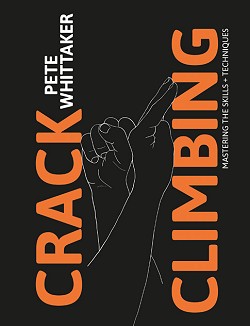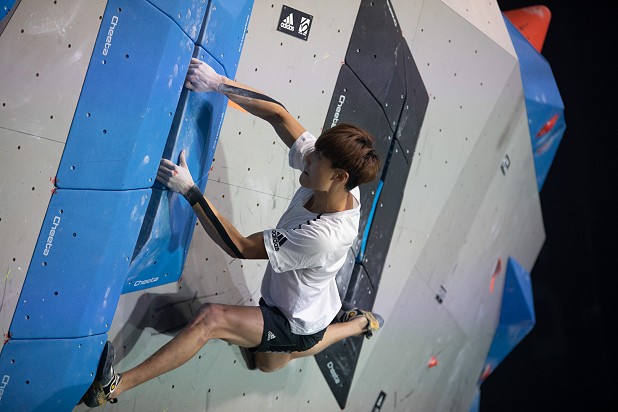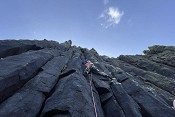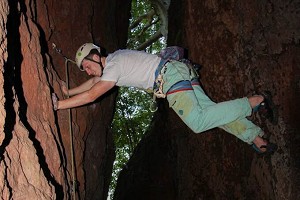
WideBoy and crack connoisseur Pete Whittaker makes the case for more cracks in climbing competitions...
There is no question about it…crack climbs have been sneaking their way into competition climbing. The whole competition scene was set alight last year when we saw Adam Ondra cruise a crack on the World Cup circuit to take the victory ahead of the poor lay-backing Japanese climbing team.
Since that event, I've seen numerous questions, thoughts and opinions from armchair critics, commentators, climbers and competition-goers themselves. It has been divisive for sure, with some throwing fire and flames from all directions, 'BURN thy crack, that gap is only air, my fingers shall not crimp it', to other opinions like 'Worship the crack, I'm weak, the jam is my only chance.'
But should they really be there and do they have a place? In one big, fat, three-letter word, YES. Of course they should. I bet you're now thinking, well of course he's going to say that, he loves crack climbing and he's the director of a company that makes crack climbing products, and whilst those two things are absolutely true, let's just take a step back and look at it from 5 slightly different points:
1. Competitors are competing to be 'the best'
Competition climbers are competing against each other to be the best. And on an international and world level, if they win they can title themselves as a World Champion Climber. i.e. 'The best climber in the world'. For me the best climber in the world shouldn't necessarily be 'the best' at all techniques that climbing has to offer. However, 'the best' should have the fundamentals of climbing movement and technique dialled down. You would expect most international comp climbers to know their drop-knee from their rock-over when making a long move, so why not know your hand jam from your thin hand jam when climbing a basic hand crack? A jam is another type of hold just like the crimp, sloper and pocket you see in every single climbing competition out there, so it should be in a comp climber's repertoire to be able to use it. The best should have an understanding of it all.
2. Surprises are good
Carrying on with the theme from above of 'comp climbers are trying to be the best'… how can you expect to be the best if you can't adapt to new situations? The best in all sports are those that adapt to the situations they are not familiar with. By throwing some cracks into competitions, all of a sudden we're separating the wheat from the chaff. 'The best' from 'the ok'. All the comp climbers are as strong as oxen these days; we all know they can hang from the Beastmaker micros for a million seconds and eat a banana at the same time. Surprises are good, throw them in there and separate these climbers on who can adapt to the situation rather than who can hang the sloper for a millisecond longer than the other one. 'The best' adapt, and at this current time in comp climbing, cracks are the new thing to adapt to.

3. Everyone thought WTF!? when the run-and-jump arrived...
I remember when the 'run, hop, skip, jump, twirl, pirouette and catch the next hold' came into comp climbing. everyone was like 'WTF is this! This ain't climbing, this is a mix between parkour and ballet, what's going on.'
But, it was used and routesetters persisted with it as it started to split the field. The climbers that could adapt won, and then everyone started training these styles of moves in their competition prep to catch up. It's now considered normal that as a competitor, you will come across some kind of bouncy run-and-jump shenanigans, either at your local comp or at World Cup level.
Now…I'm not sure about you, but I really think 'the crack' is a lot more common in a general climbing sense than the 'run, skip, jump'. The roots of climbing are in the outdoors, and in the outdoors we're much more likely to find crack climbing techniques compared to running and jumping. I have absolutely no problem with running and jumping (I'm just using it as a comparison), and I love seeing the competitors do these bizarre moves. But when we get a move that consistently crops up on the competition circuit, which represents climbing less strongly than crack climbing does, I am sat here thinking to myself…where is the crack climbing?
4. The crowd
That's right, the crowd. Climbing competitions aren't just about trying to split the competitors, they are now about entertaining an audience. Because if it wasn't about entertaining an audience, these competitions may as well be done behind closed doors and we would just see a list of results afterwards. As a sport, we're heading onto the Olympic stage, goddammit - the biggest, most-watched sporting event on the planet. With this in mind, setters are setting for the audience as much as for the competitors. The routesetters want to entertain, with unique moves and bizarre positions they can put the competitors in…and the audience 99% of the time are delighted to see this. Let's be honest it would be pretty bloody boring if there were 4 problems with a basic ladder of different sized holds and distances apart. Boooorrrrring. No-one wants to see that, the crowd wants diversity.
As an audience we're impatient, we want something different to watch, new positions, new moves to get excited about then try ourselves at our own climbing gym. 'The Rose move' was the '80s. 'Crimp, pull and lock' was the '90s. Volume climbing came in the '00s. 'Run and jump' was the teen years. We're into the '20s baby, and the '20s is crack. Give the crowd something new and something to get them talking and frothing over. I know I'm very keen on seeing Ondra 'wide ponying' whilst Megos 'tickles his trout'. Imagine this: after the comp, Sean McColl is over in the interview room explaining how he's 'over the moon', that he got his Flying Pirate to work this evening in the finals. I don't know about you, but I think that would be pretty fun to hear about in all honesty.
5. There is always a way
The final and last reason why it's a superb idea to start testing the top climbers on crack climbing problems is that there is always a way. That is the beauty of crack climbing, unless you physically can't fit your fingers inside the crack (in which case you wouldn't be jamming anyway), there is always a technique available to do the move. Where one person can hand jam another might 'thin hand' or 'fist', so really there is no problem for climbers with different-sized body parts. I mean... that's the thing about climbing anyway isn't it, you win some you loose some; that bunched-up undercut move might be easier for your shorter mate, but that long move off low foot holds is always going to be easier for the tall. It's swings and roundabouts. You give and take a little. But crack climbing…well there is always a way, always a technique to be had. Perfect. Then there should be no complaining and it's a fair field for everyone.
How far can we really go with crack climbing in competitions? Well, quite a long way really. The only cracks in competitions I've seen so far have been perfect hand cracks. When the competitors get a grasp of this, just throw in some trickier widths, angles, flares and slicknesses of crack. I think it would be fantastic to get to the point where we are mixing crack climbing techniques in with what we would now define as normal climbing. An example might be flicking upside down into some foot locks then spinning 180 degrees back through to some power volume climbing. Or crimping your way brutally into that subtle-to-find knee lock, in which the competitor can get a hands free rest and cheer to the crowd before topping out on pockets and finger jams. Folk would bloody love it. The future of comps is crack.
So, if there are any international routesetters out there who would like a crash course in crack setting and techniques to give you the confidence and ability to set in this way, please feel free to get in touch (maybe virtually for the time being)...;)

- SKILLS: How to Rope Solo - with Pete Whittaker 14 Aug, 2018
- DESTINATION GUIDE: Bohuslän, Sweden 16 Jan, 2018
- DESTINATION GUIDE: Vedauwoo, Wyoming - A Crack Climbing Paradise 19 Sep, 2017
- ARTICLE: Honnold - The Art of The Dark Lord 19 Jun, 2017
- DESTINATION GUIDE: Yosemite National Park 26 May, 2017
- DESTINATION GUIDE: Squamish 24 May, 2017


















Comments
Absolutly agree with them. Cracks are found on every crag. Some of the moves you see at comps are never replicated outdoors.
It would also be interesting to see how some climbers handle the cracks.
I'm on the fence about it! But here is a link to the comp mentioned - start ten minutes in.
https://youtu.be/nNmGnVp7Edc
Now we're into crack climbing I'm wondering if the word 'crack' refers to the type of climbing or if it's a reference to the addictive nature.
We've been training using the crack volumes at The Climbing Depot for a few weeks and gave our skills a test drive a couple of weeks back outside. No more puffing up the routes, we cruised them. I hope more of these volumes start appearing at other walls so local climbers can get their fix.
I'd like to see some mono moves - nothing looks as impressive as hanging off a single finger.
I never minded a few jamming scars after a good gritstone weekend, but mincing my hands at a wall? No thanks.